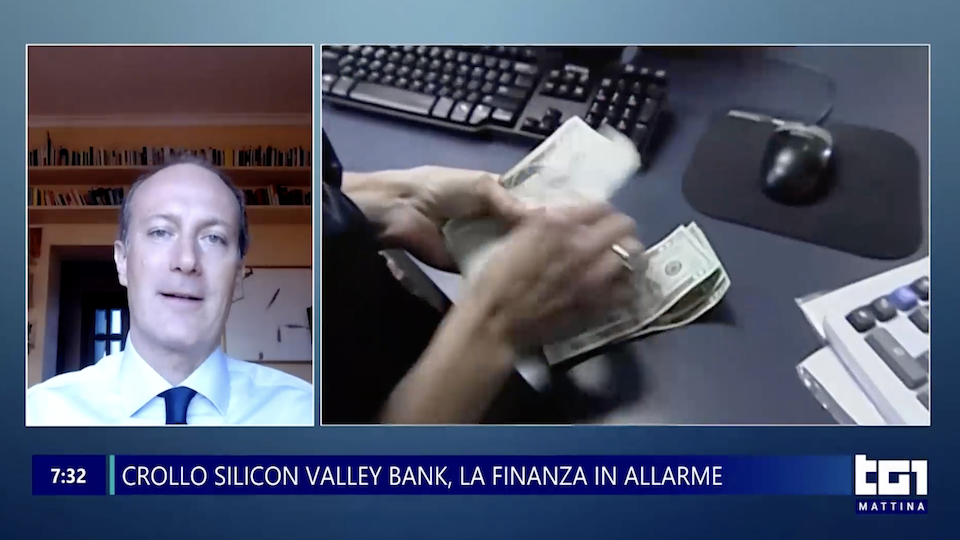Banks: It’s Not a Systemic Crisis – Tg1 RAI 1 – Pietro Paganini
The bankruptcy of Silicon Valley Bank (SVB) is not a systemic banking crisis like that of bad loans in 2008. However, the failure of SVB could trigger a domino effect on American regional banks that have similar business models and financial situations.
But what happened to SVB? Why is it not a new banking system crisis? And why does it involve the US tech sector and start-ups?
During the Special TG1 morning program on RAI 1 (main national channel), I answered these questions.
You can find the episode on RAI Play, or below you will find an excerpt from my speech.
My task is to disseminate economic knowledge and explain processes so that they are understandable to everyone. Science should not remain a mystery, otherwise, it is not science. This is my motto.
Banks: It’s Not a Systemic Crisis
Here are some key points from my speech.
Some numbers:
- SVB liquidity in deposits: USD 165 billion.
- SVB Assets: USD 209 billion.
- 30% of SVB customers cannot pay their employees at the end of the month because they are broke.
What happened, and why did SVB fail?
- Simple: SVB account holders requested some of the liquidity in their accounts, and SVB was unable to provide it. Banks never have real liquidity available because they invest those resources.
- Too much idle liquidity in deposits loses value. Banks use the investments with the account holders’ money to make profits.
- If hypothetically, all account holders withdrew their deposits, banks would need time to repay them. If investments go bad, banks are unable to repay.
READ IT AGAIN: COVID UNCOVERING THE MYSTERY >>>
This is what happened to SVB.
- In 2020, it invested part of the substantial liquidity accumulated during the pandemic in US government bonds, which are considered safe. SVB’s clients are predominantly Silicon Valley companies.
- During the pandemic, they spent and invested little, keeping liquidity in their accounts.
- The value of the US government bond decreased as the US interest rate increased in response to post-pandemic inflation. The value of the bond decreased, reducing liquidity compared to the investment, a loss.
- With the recovery of the economy, Silicon Valley companies also demanded more liquidity, to make investments and above all to cover higher costs due to inflation, but also to remedy poor industrial choices and a general malaise in the sector.
- The demand for more liquidity put SVB in difficulty, unable to provide liquidity to account holders.
- Other account holders, frightened by the risk of bankruptcy, rushed to withdraw their money, to no avail. Under pressure, the bank failed.
It is necessary to understand whether management made a wrong investment due to incompetence or fraud, as they had over a year to review their choices.
READ IT AGAIN: MILANO IS THE INNOVATION HUB >>>
Other banks.
In the meantime, other account holders of other banks in probable difficulty rushed to withdraw their deposits or sold those banks’ stock. With a chain reaction, other banks failed or are at risk of doing so.
READ IT AGAIN: FIGHTING OBESITY >>>
The Government.
The US Government and the Fed, the central bank, intervened promptly to stop the risk of contagion: reimbursing all account holders. Unlike what the law requires, not only account holders under $250,000 will be reimbursed but also those above. SVB’s account holders are predominantly Silicon Valley companies.
- The government wants to avoid SV companies running out of money, exacerbating the crisis in the tech sector.
- In California, among entrepreneurs and the public, the sense of the issue’s severity is low, with skepticism towards a crisis of systemic scope.
- The government wants to reassure bank customers around the USA, avoiding them from rushing to the bank to withdraw large sums.
WATCH IT AGAIN: GAS OWNERS NEED TRANSPARENCY – RAINEWS 24 >>>
This is not a systemic crisis like in 2008.
Back then, it was a crisis of the entire banking system with the complicity of the real estate system.
Mortgages were given to everyone without verifying their solidity and their ability to repay, that is, to pay the installments. With the slowdown of the economy, thousands of mortgage holders were unable to pay the coupons and caused the banks that insured the mortgages with deteriorated or nonexistent securities, that is, without value, to collapse.
WATCH IT AGAIN: PEACE IN UKRAINE AND THE WEST’S BIG FAILURE – OMNIBUS LA7 >>>
SVB is the failure of a single bank due to poor management that could affect other banks in the same situation. Certainly, the US control systems did not work.

